Review of popular types and varieties of pines
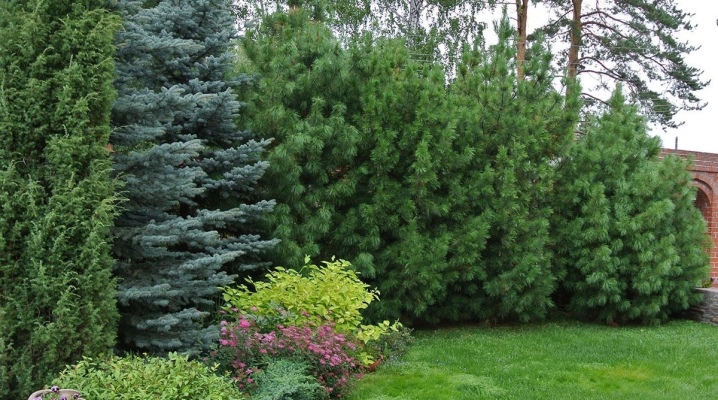
Pine is an evergreen coniferous tree that can adapt to different conditions, be it frost, heat, drought or rain. Until now, scientists cannot figure out from which word the name of the tree is derived. Some say that from the word pin (translated from the Celtic "rock" or "mountain"), others insist on picis (Latin "resin"). There are more than 200 species of pines all over the world.
The largest varieties
These evergreen crops are among the tallest plants on the planet. Many of them grow up to 70 meters, but you can find specimens of 80 meters in height.
Korabelnaya
This variety grows in the west and northeast of North America, where the harsh climate has influenced the emergence of trees with superior quality wood.
The smooth texture and attractive pattern are considered perfect for building ships.
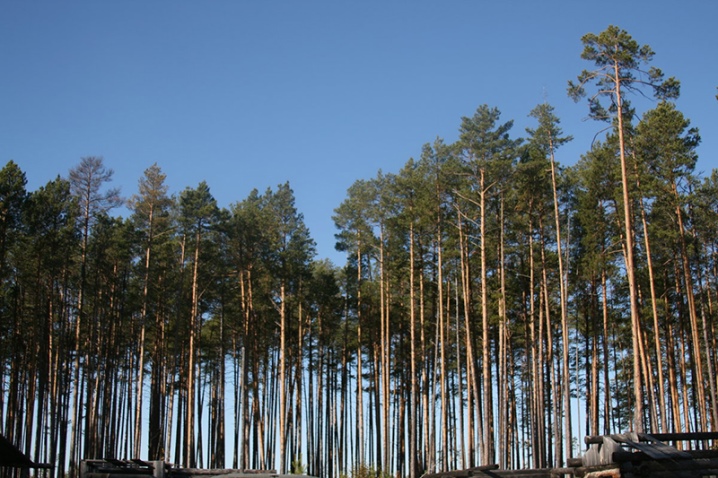
The most valuable pines are those over 100 years old. Due to their high resin content and low-weight wood, it is convenient to transport conifers along the river bed.
Specifications:
- lightweight, durable, resilient wood;
- increased resinousness;
- height - not less than 40 meters;
- width - from 0.5 meters;
- straight, even trunk without knots and branches at the base.
The ship pine is divided into three varieties: red, white, yellow.
- Red the tree grows in elevated areas and favors dry, rocky soil. Pine cones are usually red or yellow-red in color, the bark is brown or red-brown. The crown is usually round in shape.
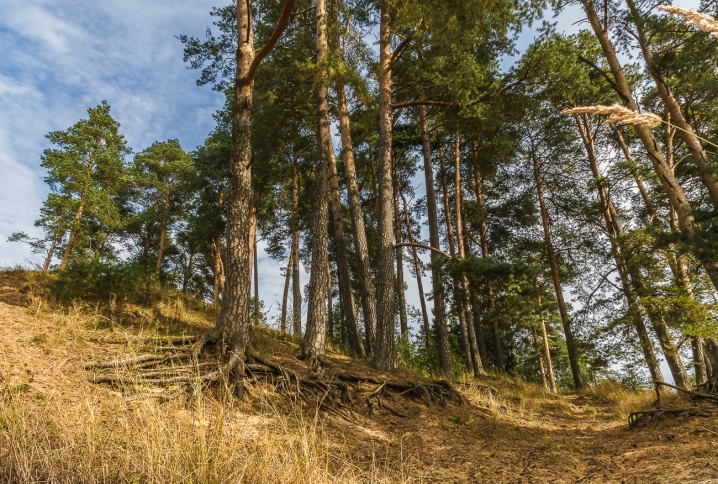
- Yellow pine has a strong, but light and elastic wood. It is highly resistant to fire. The bark at the very beginning of development has a red-brown or yellow tint, but darkens over time. The crown is round or conical. Small, spreading branches grow up and down.
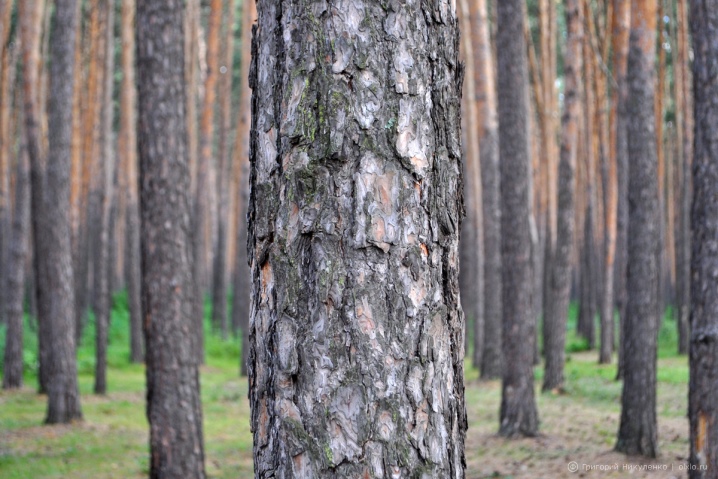
- By the white ship's pine wood is less dense than the other two. But at the same time, its material is perfectly impregnated, does not bend and is easy to process. The shade of a young tree is usually light gray, but the bark gets darker over the years. And along the entire trunk, cracks and plates begin to appear, which give the pine a purple color. The white variety grows most often in swamps and in clayey soil.
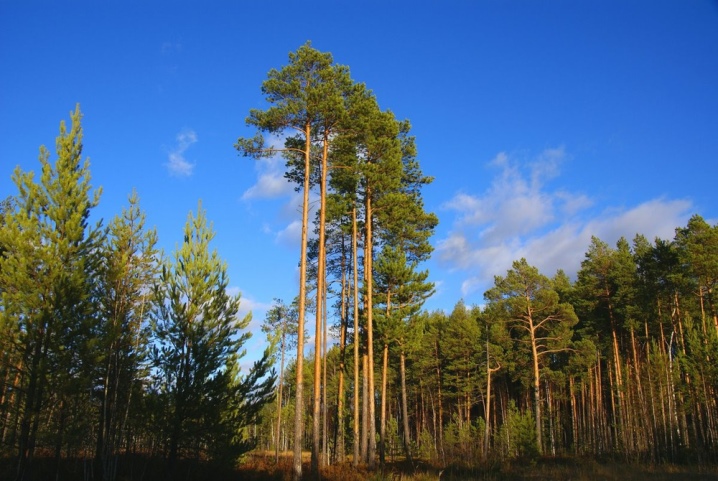
All over the world there are a number of protected areas where ship pines are protected from cutting. For example, this is a nature reserve at the junction of the Komi Republic and the Arkhangelsk region.
Karelian
The tree grows in the northern regions of Russia. It:
- differs in slow growth;
- inferior to its southern relatives in height;
- not afraid of harmful insects and fungus;
- resistant to decay.
Due to the harsh climate, such pine is characterized by a high density of wood. Therefore, it is appreciated and often used in the construction of houses.
And small products from Karelian pine are characterized by durability.
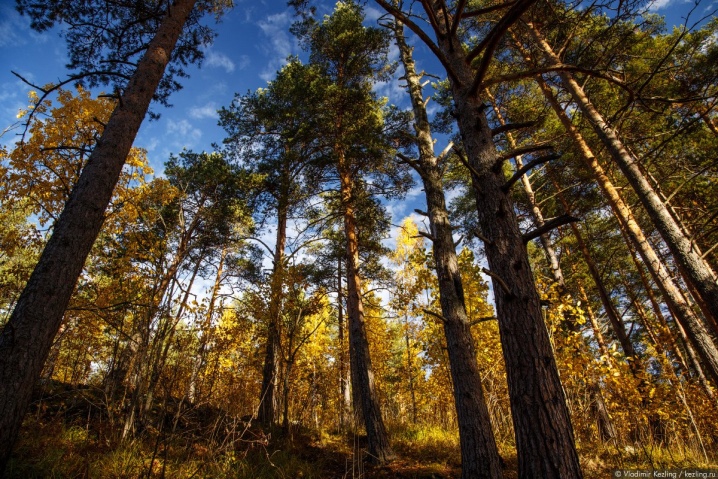
Mediterranean
Evergreen Mediterranean pines are common in the South Coast, the Caucasus, the slopes of the mountains of Spain and Italy. They are used to decorate city parks, sanatoriums, and the territory of rest homes.
The Mediterranean pines include such species as:
- Italian (pinia);
- Aleppo, Jerusalem;
- seaside, star-shaped.
The height of the Italian pine is on average 20-25 meters, but some specimens can reach 40 m. The plant has few large branches. The color of the needles is dark green. The trunk is reddish-brown, with grooves.Initially, the crown has a regular hemispherical shape, but over the years it becomes flat or umbrella-shaped.
Italian pine loves warmth and tolerates prolonged dryness well. It grows rapidly at a young age and can live up to 500 years.
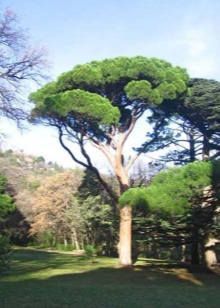
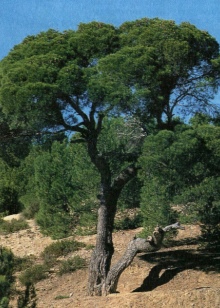
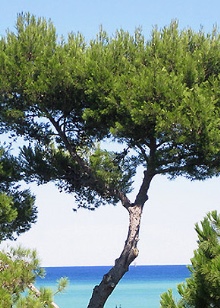
The birthplace of the Aleppo and Jerusalem subspecies is the islands and the coast of the Mediterranean, Asia. They grow up to 12 meters, but in some cases they can reach 25 meters. Trees are straight, rarely curved. Young pine trees have a smooth, dark gray trunk. The old ones are red-brown, cracked.
Crohn's changes with age. In the first decades, the top is wide-pyramidal, in subsequent years it becomes openwork and spreading. The needles are thin, soft, shiny, light green in color.
Aleppo and Jerusalem pines love light, are undemanding to soil and tolerate drought and high temperatures well. With a frost of 15-18 degrees, the tree becomes sick and dies. The average age of life is 100-150 years.
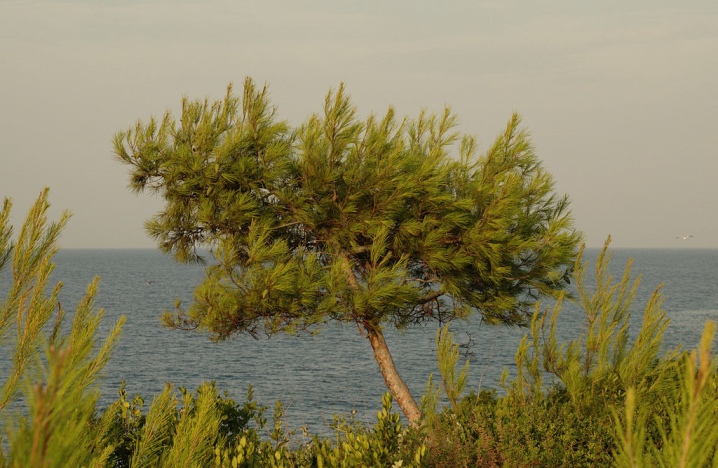
Primorskaya and star-shaped
Habitat: Mediterranean, southern coast of Europe and the Atlantic Ocean. Pine trees with red-gray trunks and deep cracks along their entire length. The young crown is red-brown in color, but brightens with age.
The needles are rough, thick and considered the longest among European pines. Its length is 15-20 centimeters. The trees grow rapidly and reach an average height of 20-30 meters. Seaside and star pines easily tolerate drought and moderate frost down to -20 degrees.
Trees carry a lot of resin. In France, the highest quality rosin and turpentine are made from it.
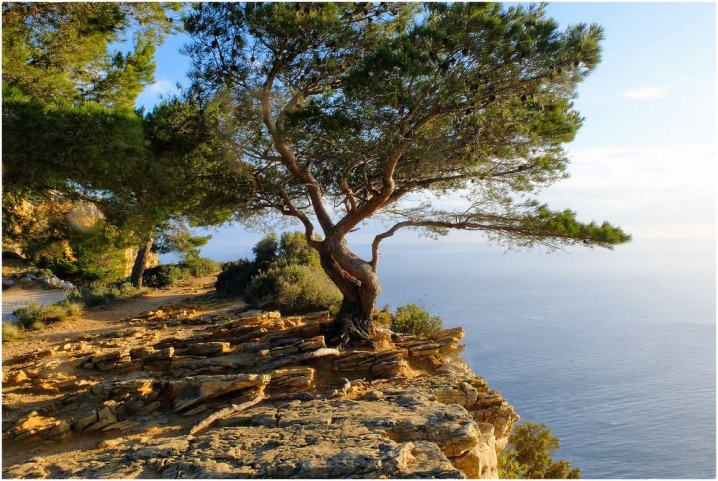
Alpine
The tree is most often called mountain pine. It grows in the mountainous surroundings of Central and South Asia. It is used to decorate the territory, strengthen plantings, cover slopes and slopes.
Specifications:
- spherical or ovoid crown;
- the young trunk is smooth, with a gray-brown tint; over time, dark scales form at the top;
- slow growth;
- needles are rough, dark green in color;
- plants live up to 1000 years.
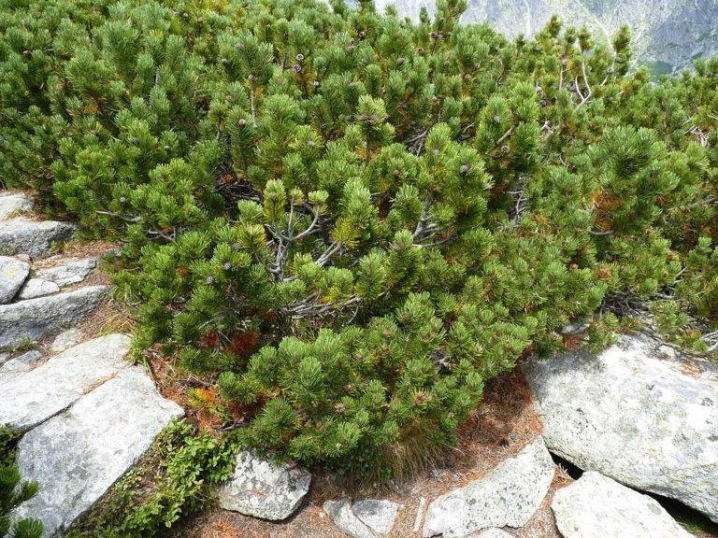
Various joinery and turning products are often made from wood of the Alpine subspecies.
Young cones and shoots are used in medicine and cosmetology. The seeds are used to make oils.

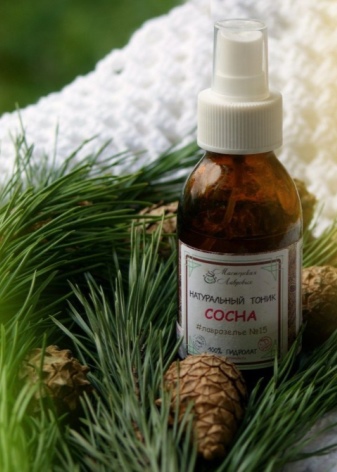
Medium sized species
Pine trees of medium size grow to about 25-30 meters. They are used to decorate spacious areas, personal plots, holiday homes.
Yellow
This tree is also called Oregon because of its main habitat - Oregon (USA). It can also be found in Canada and Mexico.
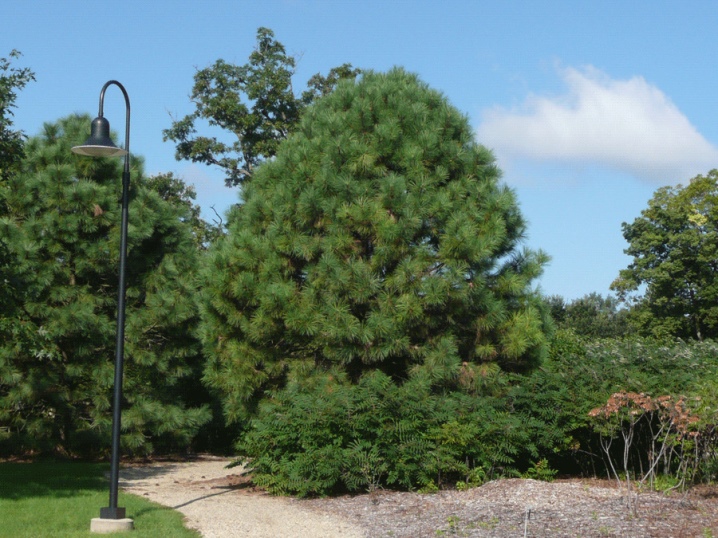
Description:
- wood is fire resistant;
- life expectancy - 300-600 years;
- branches are sparse, arcuate, at an early age they rise, at a more mature age they hang down;
- the trunk is yellow or red-brown, with large cracks;
- the needles are curved, flexible, green in color, with white longitudinal lines.
Squirrels and quails feed on the fruits of yellow pine. Nutcrackers and chipmunks help spread the species across the United States by hiding seeds for the winter.


Relic
This type of evergreen beauties is most often called Pitsunda pines. The coniferous tree grows in the Krasnodar Territory, in the south of Crimea, in Abkhazia, Georgia and Gelendzhik. This is the most ancient species that came to the modern world from the preglacial period.
Main characteristics:
- height - up to 25 meters;
- width - up to 30 centimeters, but you can also find trees whose trunk diameter reaches 100 centimeters;
- long soft needles that grow up to 18 centimeters;
- the trunk is brown-gray, with cracks along its entire length;
- the crown is sparse, with branches diverging in all directions;
- life expectancy is up to 80 years.
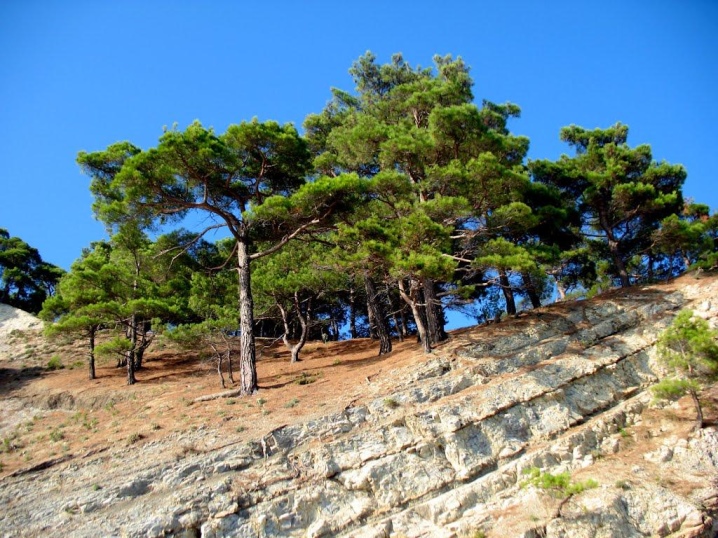
The tree feels great in adverse conditions. It easily tolerates drought and environmental pollution. But the pine needs an air temperature of at least 25 degrees Celsius, otherwise the plant can get sick and die. Recently, the population of relict pine has been dramatically decreasing. This is due to fires and deforestation to expand recreation areas. Therefore, the coniferous tree is listed in the Red Book.
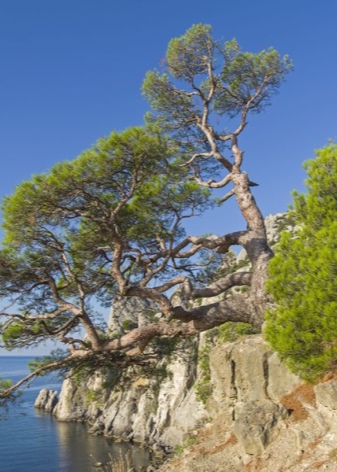

Spinous
This tree makes an indelible impression on everyone who saw it live. Colorado, New Mexico, Nevada are considered the birthplace of pine. Let's consider some of its features:
- grows up to 5-15 meters;
- the trunk is gray-brown in color, with scales;
- the bark is strong and resinous;
- needles are usually of two shades: dark green and bluish green, needles are short, dense and dense, branches are raised;
- lives up to 1000 years, but there are trees that have lived up to 1500 and even up to 2500 years;
- resistant to fungal diseases and harmful insects;
- ideal for gardens and vegetable gardens, pine grows slowly and is easy to prune;
- an unpretentious evergreen tree that survives where it is very difficult to survive: on mountain slopes, talus, crevices, on poor soil, during prolonged drought and strong winds.

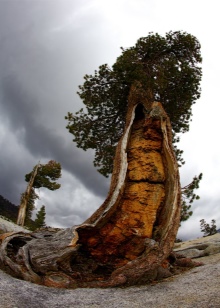
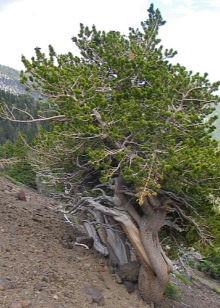
An interesting fact is that the bristlecone pine still lives on the earth - the same age as the Egyptian pyramids... Today it is more than 4,700 years old. This coniferous tree is considered one of the oldest on the planet and is protected by the state.
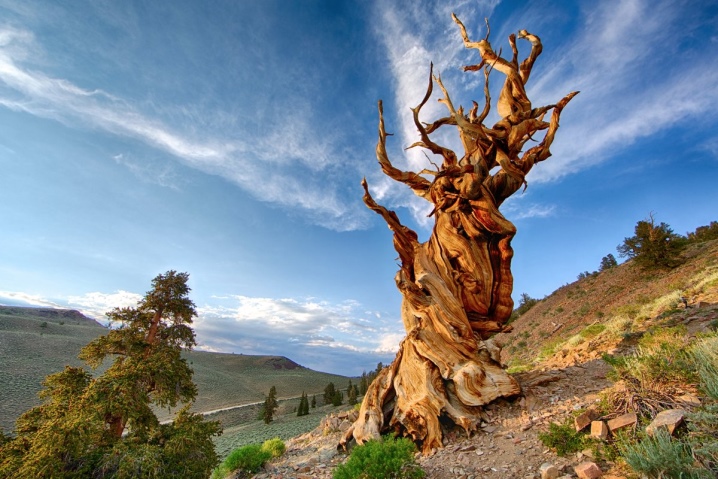
Dense-flowered
This is a bright representative of evergreens. Unfortunately, the pine tree is on the verge of extinction. Natural habitat: China, Korea, Japan, Primorsky Krai.
Peculiarities:
- thick, beautiful, but thin needles;
- the crown is round, spreading and wide;
- does not tolerate drought, loves heat, moisture, sunlight, therefore it most often grows on stony soils next to water bodies;
- grows up to 10-15 meters;
- the trunk is red-brown or dark brown, very curved;
- can withstand frosts down to -34 degrees;
- not adapted to survival in urban conditions.
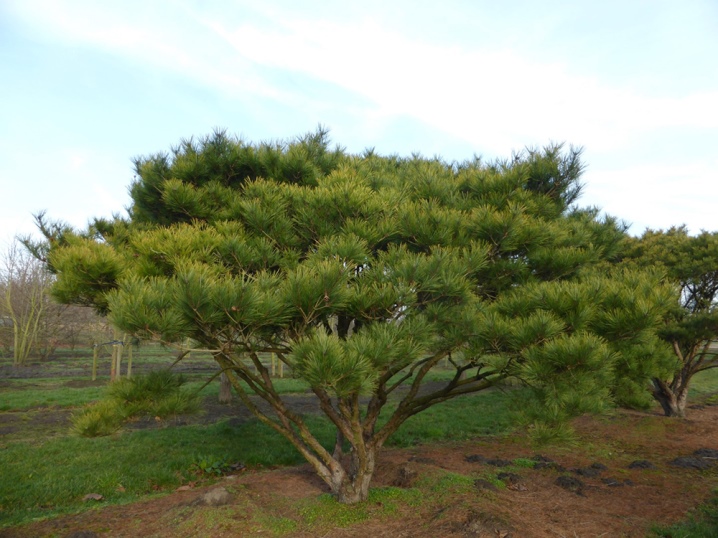
It is rare to see forests with densely flowered pines. They prefer to grow in small groups, but like to coexist with other types of trees. For example, with beech, birch, oak.
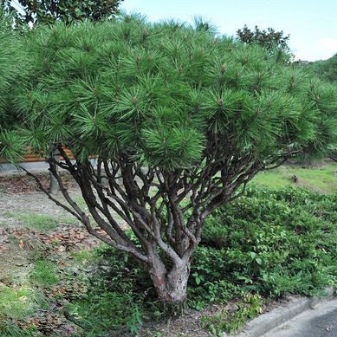
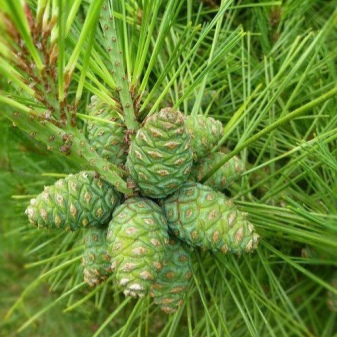
Serbian
One of the best trees for decorating a garden or vegetable garden is the Serbian pine. It attracts not only with its beauty, but also with its durability and unpretentiousness. Grows in Serbia, Bosnia and Herzegovina, Bulgaria.
Specifications:
- grows up to 15-20 meters;
- width - 3-4 meters;
- resistant to frost, winds, lack of sunlight, harmful insects, diseases;
- afraid of aphids and spider mites;
- can grow on the most unfavorable soils;
- the crown is dense, low-slung, acute conical shape;
- branches are short and curved;
- the trunk is red-brown, straight, lamellar;
- the needles are dense, sharp, with a pronounced keel, do not change their shade throughout the year;
- adapts well to the urban environment, is not afraid of gas pollution and smoke.

Schwerin pine
Pine of medium size, which perfectly coexists with plants in the garden and looks spectacular in open areas. It grows in Central and Southern Europe, in the North Caucasus.
Specifications:
- not afraid of frosts down to -30 degrees;
- loves sunlight and does not tolerate waterlogged soil;
- grows up to 10 meters;
- does not require pruning;
- length of needles - 10-12 cm;
- pyramidal dense crown with a silvery-blue tint;
- lives from 30 to 60 years.
The tree got its name from Count Schwerin. He independently bred this species of conifers in 1905.

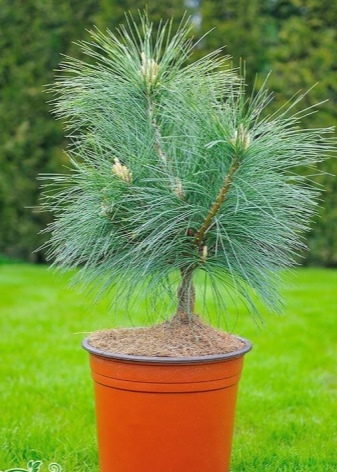
Chinese
Habitat: China, Korean Peninsula. Outside these areas, Chinese pine can only be found in botanical gardens.
Description:
- at the very beginning of life, it has a rapid growth rate, which decreases over the years;
- reaches 30 meters in height;
- has a flat crown;
- the bark is dark gray or gray-brown with deep cracks;
- the needles are shiny, gray-green;
- afraid of fungus and various harmful insects that infect the bark.
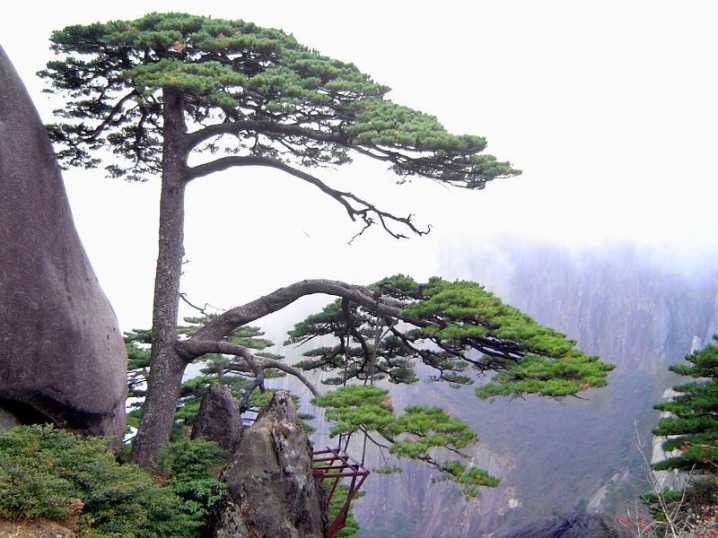
Very often, Chinese pine is used to build load-bearing structures. And its resins are used:
- in medicine - for the treatment of respiratory diseases;
- in cooking, for flavoring vanilla;
- on the farm - for the manufacture of turpentine and related products.
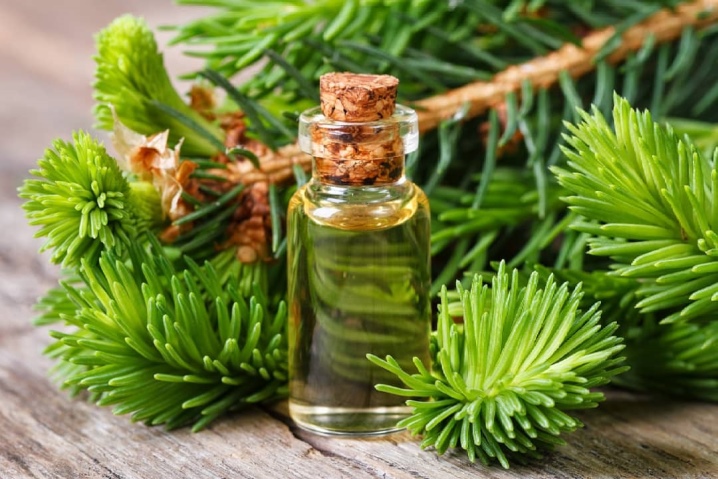
Dwarf pines
Low-growing pines are not inferior in beauty to their giant counterparts.
When decorating plots, summer residents usually prefer dwarf bush trees.
These plants have many benefits:
- undemanding in care;
- grow slowly;
- have a small height (no higher than three meters);
- frost-resistant;
- adapted to any soil;
- practically do not get sick;
- coexist well with other plants;
- have a long life span.
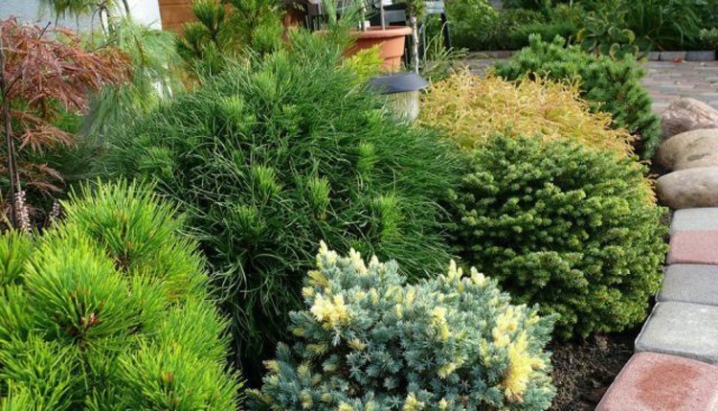
Consider the most popular dwarf varieties with a description.
Creeping
It is a coniferous shrub. Habitat: mountain ranges and foothills of Central and Southern Europe.
Peculiarities:
- shrub pyramidal or spherical;
- the bark is gray-brown;
- in young pines, the trunk is smooth, in older pines it is covered with plates along the entire length;
- needles are dark green, short, firm, but not sharp.
Due to its unpretentiousness, creeping pine is used for landscaping city parks and alleys, private estates.


Belokorya
The western part of North America is considered a natural habitat. It can be found in the area of the Cascade and Rocky Mountains. There, the evergreen beauty is the tallest tree.
Some features:
- at an early age, the crown has a conical shape, over time it becomes rounded;
- the bark is white, smooth, but scales begin to appear over the years;
- the needles are sharp with rounded ends, of a yellow-green hue.
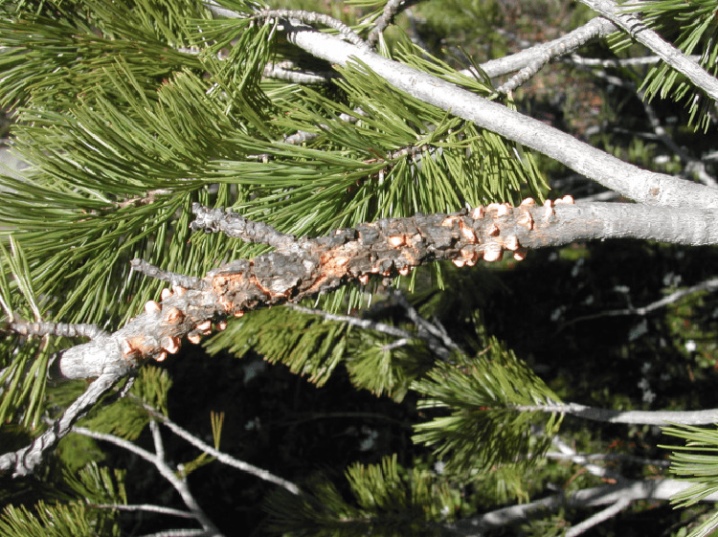
White pine is divided into a large number of varieties, varying in size. The following types can be distinguished from dwarf ones:
- "Compact jam";
- "Satellite";
- pine of Schmidt;
- "Compact Glauk";
- elfin "Glauka".
"Compact jam"
It grows up to 1.5 m in height and 1 m in width. The crown is dense, pyramidal in shape, which does not change with age. Dark green needles, hard, shiny. Pine does not require special care, loves light, can grow well in dry soil.
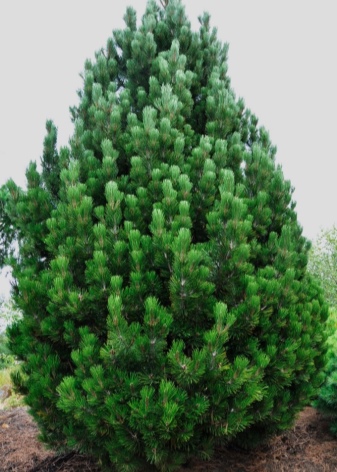
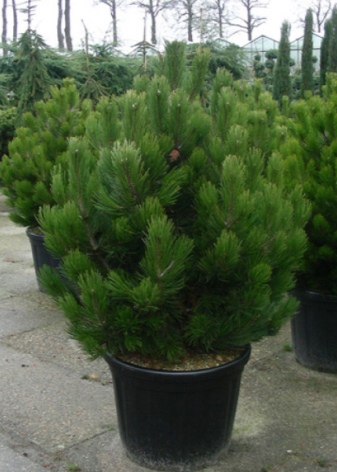
"Satellite"
It grows no more than 2.5 m in height and 1.5 m in width. The branches grow close to each other and create a pyramidal shape. The needles are green, the needles are long and twisted. Pine "Satellite" is undemanding to soil, but cannot do without sunlight.
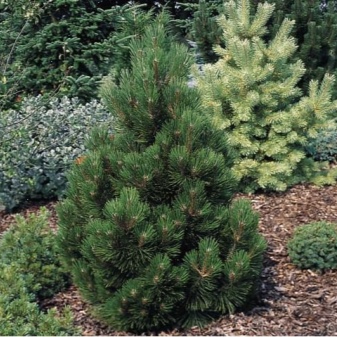
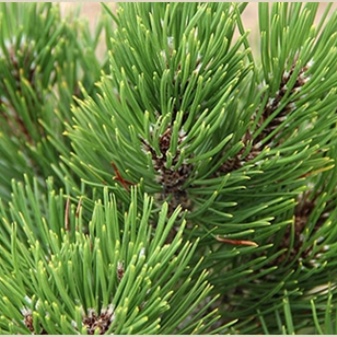
Pine Schmidt
It is a tree with a very slow growth rate. Basically, this species grows no more than 30 centimeters in length and width. The needles are long, sharp, light green in color. Densely growing dense branches create a spherical shape. Pine loves light areas, does not require a lot of moisture.

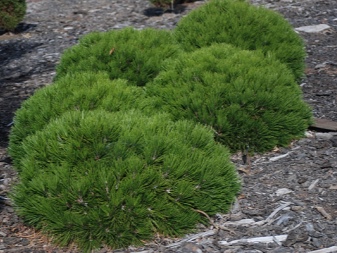
"Compact Glauk"
It occurs naturally in the mountains at an altitude of 1,300 to 2,500 meters from southern France to the eastern Alps.
Specifications:
- pine loves sunlight;
- not afraid of frost;
- resistant to harmful insects and diseases;
- the crown is oval, the needles are green-blue.
It grows up to 1.7 m in length and up to 1.6 m in width. This tree has beautiful needles and miniature dimensions.

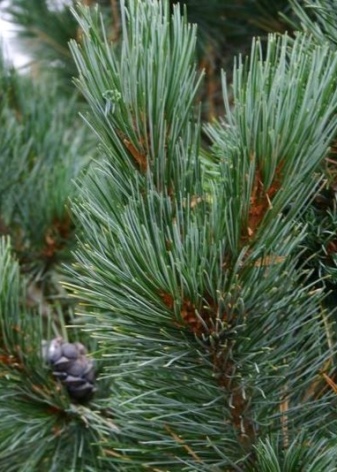
Plum tree "Glauka"
Dwarf "Glauka" grows throughout the territory from Primorye to the Arctic Circle. Some features:
- dense green crown;
- loves sunlight and drained soil;
- does not tolerate heat, but tolerates frost;
- very low growth rate: during life it reaches 3 meters in height and 4 meters in width.
Plane "Glauka" looks great on every personal plot and complements any design idea.

Unusual options
There are a large number of unique evergreen trees on the planet, which are beautiful and unusual in their own way.
Bunge
The tree has another name - lacy pine. It grows in the center and northwest of China. The height of the culture is up to 30 cm, the trunk is smooth, gray-green in color, the needles are hard, long, dark green in color.
The tree is considered unusual due to the fact that scales are located on the trunk, which eventually fall off and give the bark an orange-white pattern.
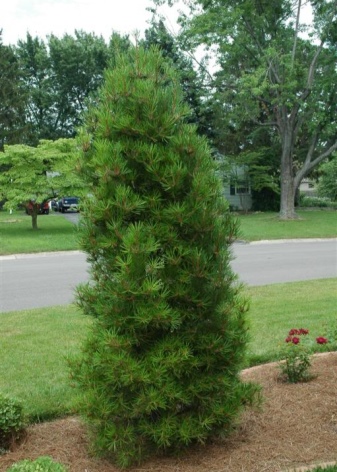
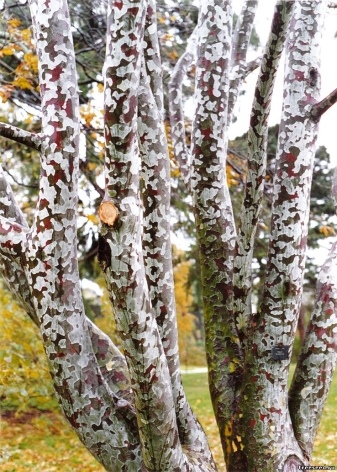
Swamp
It is also called long-coniferous. This tree is the symbol of the state of Alabama. It can be found in southeastern North America, from Virginia and North Carolina to Louisiana and Texas.
Description:
- grows up to 47 meters in height and up to 1.2 m in width;
- the trunk is straight, orange-brown, with scales;
- crown is rare, round, needles are long, straight, yellow-green;
- resistant to fires.
Marsh pine wood is highly valued due to its increased resin content and strength. From this material ships, living quarters are built, and turpentine is produced from resin.

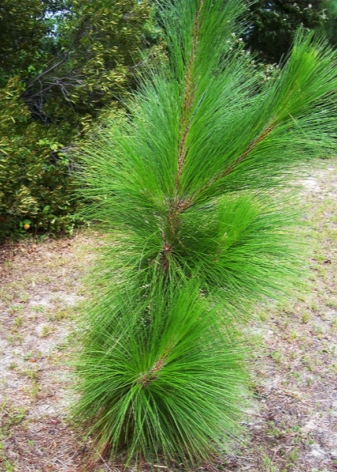
Twisted
It grows in the west of North America. It has another name - rotated pine.
Peculiarities:
- the trunk is straight, slender;
- bark gray-brown or red-brown, with plates;
- height - up to 50 meters, width - up to 0.5 meters;
- needles are hard, curved, dark green;
- grows well in deep, drained soils;
- can coexist with other trees: pine, fir, pseudo-tree.
Pine grows well in urban environments. Not of interest in decorative and silvicultural terms.
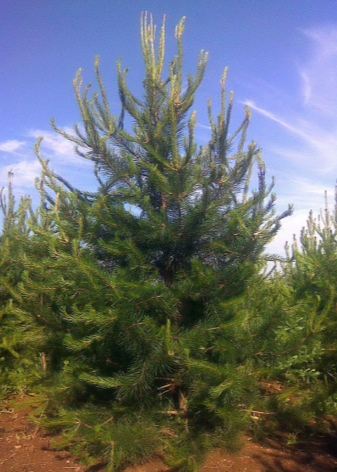

Canary
Lives on the west coast of Africa. Canary pine is similar to spruce. Wood is considered a valuable building material because of its strength and fire resistance.
Peculiarities:
- grows up to 35 meters;
- straight trunk of yellow tint;
- the young crown is pyramidal, with age it grows in width;
- young trees have blue needles, older ones - green and shiny;
- resistant to aridity, grows on any soil;
- has the ability to quickly recover from fire or felling.
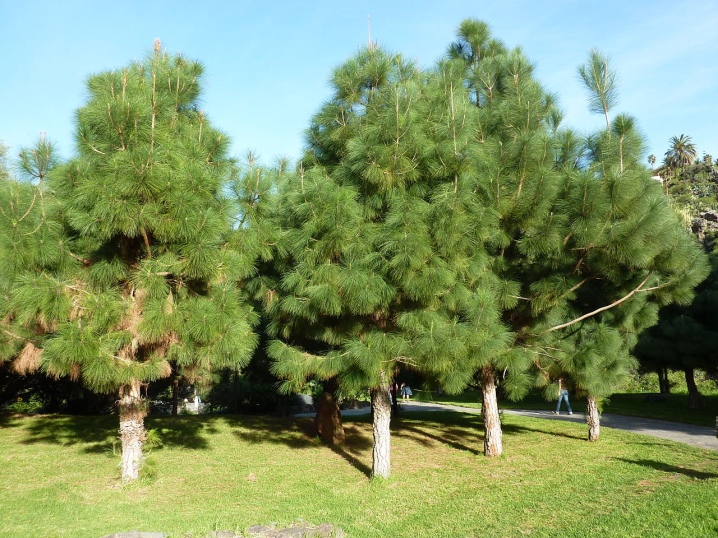
Canary pine moistens the soil due to the condensation of water on the needles. Therefore, other shrubs and trees constantly coexist with it.
Pine is a unique tree that is of great importance in the industry.
In Russia, pine is listed as the most important tree, which is used everywhere, in a variety of fields: from construction and mining to the production of office supplies.
An interesting fact is that pine has powerful antiseptic properties. For example, in a pine forest there are only 500 microbes per 1 square meter of air, and in a city with a large population - 35 thousand.
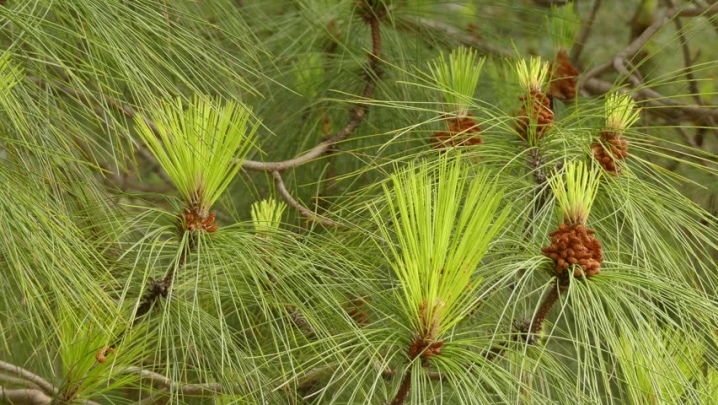
The following video will tell you how to choose pine trees for your site.



































































The comment was sent successfully.